
House Speaker Nancy Pelosi (D-CA) and House Intelligence Committee Chairman Adam Schiff (D-CA) update members of the media on the latest developments related to the impeachment inquiry focused on President Donald Trump on October 2, 2019, on Capitol Hill in Washington, DC. (Credit: Tom Brenner/Getty Images )
How the Trump inquiry compares to those of the past
Only three past presidents have been seriously threatened with removal from office. A historian compares those situations to the current impeachment inquiry.

The formal opening of an impeachment inquiry against President Donald Trump late last month has focused the nation’s attention on what happens next. What does history suggest?
The impeachment power, as outlined in Article II of the US Constitution, is straightforward but also vague: “The President, Vice President, and all civil Officers of the United States, shall be removed from Office on Impeachment for, and Conviction of, Treason, Bribery, or other high Crimes and Misdemeanors.”
Over the two centuries since the nation’s founding, just three other presidents have been seriously threatened with removal from office: Andrew Johnson and Bill Clinton, who were impeached by the House but acquitted in Senate trials, and Richard Nixon, who resigned as impeachment loomed.
If Trump is next in line, what does history teach us?
Here, Mary Frances Berry, professor of American social thought and professor of history at the University of Pennsylvania, discusses the historical parallels and what sets this moment apart:
The post How the Trump inquiry compares to those of the past appeared first on Futurity.
Share this article:
This article uses material from the Futurity article, and is licenced under a CC BY-SA 4.0 International License. Images, videos and audio are available under their respective licenses.


